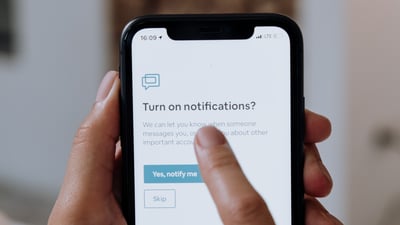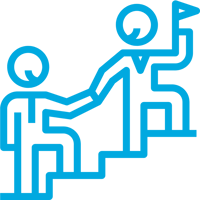Leave These 7 Membership Mistakes Behind
Kick these membership bad habits to the curb to shift your focus on creating an engaging member experience.
Member engagement is crucial to your success; learn tips for using your association software to encourage members to get involved and remain active.
We all know the key to retention is greater engagement of members. But what do you do when members just aren’t engaging the way you’d like? No matter how amazing your association benefits may be, there will always be some members who resist getting involved. It’s your challenge to draw them in, get them hooked on the value you deliver, and entice them to stick around. It’s far more cost effective to keep the members you have than to get new ones — but it sometimes requires a little creativity. Below, we’ve assembled seven winning engagement techniques we’ve gleaned from our clients. Try a few to see how they work for you:

Member engagement can have a direct correlation to retention, but it’s nuanced. You can have a deeply engaged member who drops out, or one who never engages but remains loyal. It’s important to step back and try to spot the unique trends within your association.
Your member management system should help you do this by:
• Measuring engagement
• Tracking how it rises and falls
• Providing insights you can use to prevent disengagement down the road
If your current association software doesn’t support this, you’ll want to address that as part of the digital transformation strategy you’ve hopefully already started. Check out our blog post if you need some advice on how to approach your transformation initiative.

You need to look at your engagement trends over the past few years:
• Has there been a steady increase or decrease in engagement?
• Is it affecting a particular demographic group, such as recent graduates or seasoned professionals who don’t feel they need to network as much?
• How does engagement correspond to your retention levels — is there an exodus after the first year?
While you’ll want to go back several years to determine patterns, you also need to specifically look at the past two years. COVID-19 changed everything and the data from three years ago, while helpful, may not accurately predict what you’ll be seeing in the future. You may find engagement has increased significantly — but is that sustainable?
As you look at your data, it’s essential to recognize how members stopped engaging. Was it sudden, gradual, or non-existent from the start? The reengagement approach for each of these groups will differ:
• Gradual Decline: Those who slowly stopped participating can be the easiest group to bring back into the fold. They’ve already signaled an interest in your association and with some well-timed strategies, you should be able to get them excited again.
• Abrupt Disengagement: Those who were involved but stopped on a dime could be an indicator of something your association did/didn’t do. If the data shows engagement dipped during a certain period, you’ll want to review what was happening at that time: Did you decrease member benefits, raise dues, change the renewal process, or discontinue a favorite resource?
• Never Engaged: This can be harder to address because it’s vital to first understand why they never participated. Was it in their nature to observe vs. participate — or did they somehow fall through the cracks in your onboarding process? You’ll want to dig deeper to try to learn the cause so you can develop an effective reengagement strategy.
Personas are crucial to engagement and retention. If you haven’t developed member personas, you’ll want to start now so you can build up a reservoir of information on their attitudes, habits, career goals, and interests that you can use to tailor communications and engagement offers. If you need some guidance, our friends at Higher Logic have posted a great blog about how to build member personas.

It’s important to ask your members how they prefer you to communicate with them. Prior to COVID, some might have preferred snail mail, so they had physical documents/publications available to them in the office. Now, they’re working from home and email is critical, but some might prefer text or push notifications. Your member management system should have the capability to ask for and retain member preferences. And, if you haven’t asked since COVID, ask again. Then, make sure you honor their requests.
Armed with defined personas, you can then communicate with members about the specific benefits they appreciate (events, whitepapers, directories, discounts, etc.) and skip the ones that don’t matter to them.
With a persona, you’re gathering bits of information that help you understand the characteristics of a particular group within your association. But the way you communicate can differ depending on whether they tend to be introverted or extroverted.
Introverts might prefer to:
• Receive written communications
• Access resources on their own
• Update their own profiles
• Attend off-camera online events

Extroverts might prefer to:
• Get a phone call
• Attend an in-person event
• Join a forum in your app
• Jump on a Zoom call with other members

Indeed.com has a helpful article you might want to read to learn more about these personality types.
Many corporate and individual members will join an association specifically for professional development — whether certification/licensing, training, or networking. Depending on the persona, make sure you’re communicating with them about how they can reach their specific goals and understand how these might have changed significantly since COVID. You may want to consider a Learning Management System (LMS) to provide a connected, personalized learning experience and help manage certifications.

While it might be puzzling to some people given our tech-obsessed era, there are still corporate and individual members who haven’t totally embraced the use of technology and they may be reluctant to tell you. If your data analysis suggests that some members were highly engaged at in-person events and networking opportunities before COVID but have virtually disappeared (pun intended), you need to consider launching a user-friendly campaign to help them understand how to take advantage of your website and other online resources — either as part of your onboarding program or as a separate initiative. See our recent blog post featuring tips to improve the onboarding journey.
No, this is not an oxymoron — you can highly automate the production of very personalized communications that will make your members feel special.
By setting up your member personas, personalized communications can be quite easy to administer. Your member management system should help you:
• Determine which processes to automate
• Identify ways to streamline your outreach
• Measure how well it’s working
Depending on member preferences, you can create multi-faceted email campaigns, generate a text campaign, or send push notifications via your mobile app.

Your website is another place where you can instantly make your members feel welcome and seen. If your website and database are one, you can serve up personalized, highly targeted content and resources that speak directly to their interests.
In this blog, we’ve addressed the need to consider creating a digital transformation strategy. Part of that requires looking at your Digital Member Value Proposition to ensure your most popular benefits can be delivered online. Your transformation initiative should include reviews of your:
• Business model
• Operational processes
• Technology you use to support your efforts
• Overall corporate culture
There’s no better way to understand members’ needs and attitudes than by asking them. Some may tell you, others might not, but nearly all will appreciate being asked — as long as you make it simple for them to respond.
Your organization may occasionally survey members, but you might need to increase the frequency from yearly to quarterly or even monthly, depending on your industry. Needs are constantly changing and it’s important that you stay on top of evolving attitudes. The survey doesn’t have to be long — identify the top five data points you need. The survey should take members no more than 3 minutes to complete and will provide a goldmine of information.
If you have a year-round mobile app, polling your members on key topics can be incredibly simple for you and them. You can get real-time responses to pressing questions and members will feel more a part of your association’s mission as a result. If you don’t have a year-round app, take a look at our blog post for some tips on getting started.

Through your data analysis on engagement and the correlation between engagement and retention, you need to look closely at the greatest attrition risks. For trade organizations, the loss of just one major member can be devastating, so you need to identify those most in jeopardy and devise a personalized plan to ensure their continued involvement.
This plan might include creating a special high-level retention team that includes representatives from key departments within your association who:
• Reach out to the member
• Invite them to special events
• Appoint them to powerful committees or even the Board
It’s essential to have a plan in place to address at-risk members well in advance of their anniversary date.
Depending on where the member stands on their career path, they may benefit from a mentor. If they’re a young professional who needs to be licensed (accountants, attorneys, health care workers, etc.), they may appreciate help in navigating that process. If they’re new to your organization (regardless of their professional experience level) they may need help to take advantage of all you offer. Volunteer mentors can be drawn from your most engaged and loyal membership base, and you can create a program that ensures these volunteers are recognized and rewarded.

Fear of Missing Out (FOMO) can be a powerful motivator. Some types of members will respond well if you can create a sense of belonging among their peers and emphasize what they will miss if they don’t remain engaged. Not all member types will respond to this tactic, but it’s another approach you can try.
For many associations, advocacy efforts are a central part of the mission — and certain industry or professional issues may be a strong draw for some members. As part of your persona building, identify members who have a particular interest in advocacy and then:
• Keep them regularly informed about your progress
• Invite them to comment
• Give them plenty of opportunities to take action
Everyone likes to be appreciated and frequently recognizing your most active and loyal members can go a long way towards keeping them engaged — and it can motivate others who aspire to their levels.
You can easily recognize top corporate or individual members with attainable achievement awards that celebrate:
• Levels of involvement
• Longevity
• Outstanding industry accomplishments
• Above-and-beyond participation in your events
• Other distinctions that are meaningful to you and your members

Awards can help generate excitement around some of your biggest needs (Hello, new-member recruiting). The actual award can be as simple as a certificate, plaque, trophy, or gift card — you can go as elaborate as your imagination (and budget) allows. There are solutions on the market that can help with this; look for one unified platform that can:
• Collect entries online
• Provide advanced analytics
• Streamline/automate your processes
• Simplify internal and external communications
Committees: Like most associations, you have committee assignments that are coveted by the membership for professional development reasons. You probably reward members who have made a real difference to your association with these assignments and should let it be known how they were selected to help motivate others to step-up their game
Speaking Engagements: The same can be said about conference speakers — if members understand these spots go to recurring members who are active in your organization, it can help boost engagement rates.
This is an easy thing to do. Many associations post profiles of new members but loyal members who renew year after year don’t always get the recognition they deserve. You can easily offer kudos to members who have helped you and celebrate their achievements.
Bottomline: You can never over-thank your members.
Happy, engaged members lead to higher retention rates. To keep your members actively participating in your association, remember to:
• Analyze your data for emerging trends
• Build member personas to help personalize your communications
• Use your association software to automate engagement processes
• Ask your members for feedback
• Develop a plan to address at-risk members
• Reward your members for their loyalty
Kick these membership bad habits to the curb to shift your focus on creating an engaging member experience.
How engaging is your association’s member web experience? Entice your members by offering dynamic and engaging content.
Leveraging your current membership renewal rates is the key to sustainable growth; discover three strategies to help you focus on your core members.